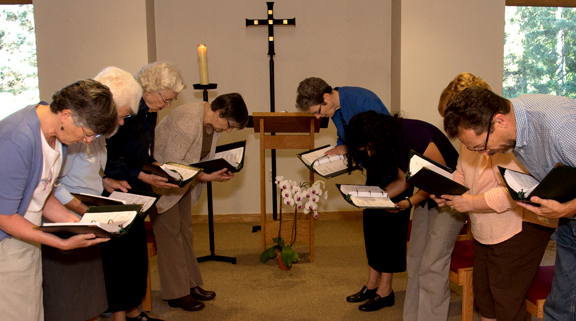I recently read a quotation on creative tension that has me intrigued. It was entitled: The Tension of Opposites and the Power of Love:
“… all our lives we are faced with the task of reconciling opposites which, in logical thought, cannot be reconciled… How can one reconcile the demands of freedom and discipline in education? Countless mothers and teachers, in fact, do it, but no one can write down a solution. They do it by bringing into the situation a force that belongs to a higher level where opposites are transcended—the power of love… Divergent problems, as it were, force us to strain ourselves to a level above ourselves; they demand, and they provoke the supply of, forces from a higher level, thus bringing love, beauty, goodness and truth into our lives. It is only with the help of these higher forces that the opposites can be reconciled in the living situation.” – E.F. Schumacher (quoted in Weavings: A Journal of the Christian Spiritual Life, Vol XXIV:2 March/April 2009, p. 29)
In many ways, Benedictine life is built on this creative tension of opposites. Perhaps that is why, when lived well, monastic life brings people to integration. As Benedictines, we promise both stability and conversion of life, an openness to continual change. We are called to balance the needs of the individual with the needs of the community.
In the Rule of Benedict, Chapter 72, Benedict writes: “No monastics are to pursue what they judge better for themselves, but instead, what they judge better for someone else.” Benedictine life is ordered around the structure of common prayer, common meals, set times for work and leisure, and each sister is called to find her inner freedom within that structure. Leadership, as Benedict envisions it, combines two opposite modes of relationships: obedience to the abbot or prioress, and mutual obedience and service among the monks one to another. You who live outside the monastery know that these or similar tensions exist in marriage and work life as well.
Schumacher says that it is precisely by holding both sides of these tensions together that we mature and deepen in life. It is much easier for any of us to come down on one side of the tension or the other. It is easier to say, “I’ll have it my way,” than to bend my will to a larger good such as the care of children or what ultimately serves the greater good for all.
What I know from living Benedictine life is that, as Schumacher says, we need those “forces from a higher level, thus bringing love, beauty, goodness and truth into our lives” to hold the tension. Benedict writes: “Among themselves, they show the pure love of sisters and brothers; to God, reverent love; to their prioress or abbot, unfeigned and humble love.” (Rule of Benedict, Chapter 72) It is this love, God’s love, that helps us stay in the tension until it yields life.
The character of Rose Maxson in the film Fences illustrates this beautifully. With great struggle, she holds in tension her dreams for herself and the needs of her family, what is good for her and what is better for another. Holding these tensions demands and calls forth great love and truth in her life. Holding the tension comes at a cost. But by the end of the film, we see the depth of spirit and generativity that her life makes possible.
The cross is the symbol in the Christian faith for holding the tension of opposites: divine and human life; obedience and freedom, love and suffering. The resurrection reveals the mystery of life that arises from holding fast to this creative tension and calling forth the higher forces of love, beauty, goodness and truth.
____________________
Read other blog posts in Lynne’s series, Building Community.



